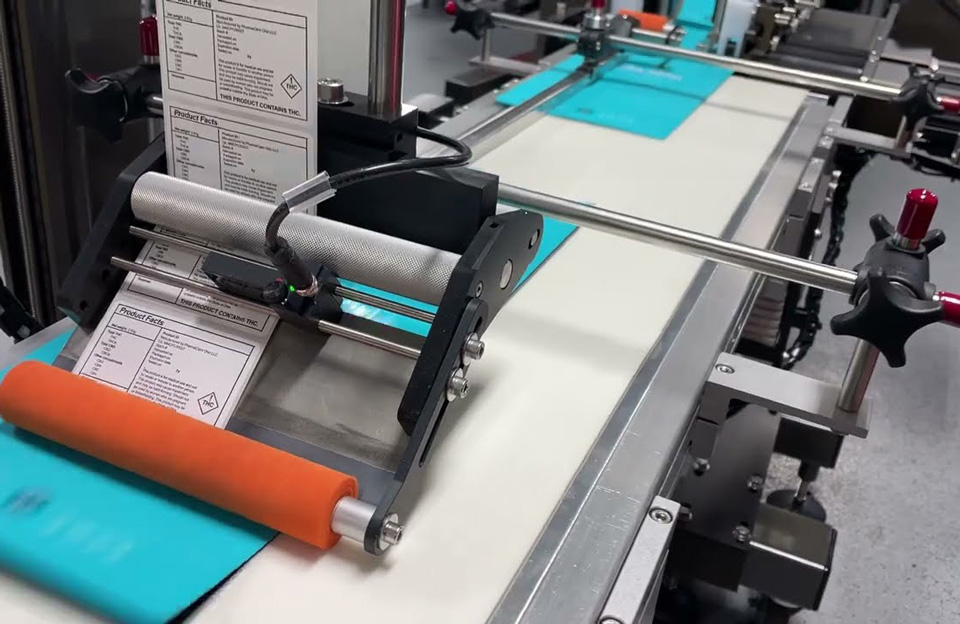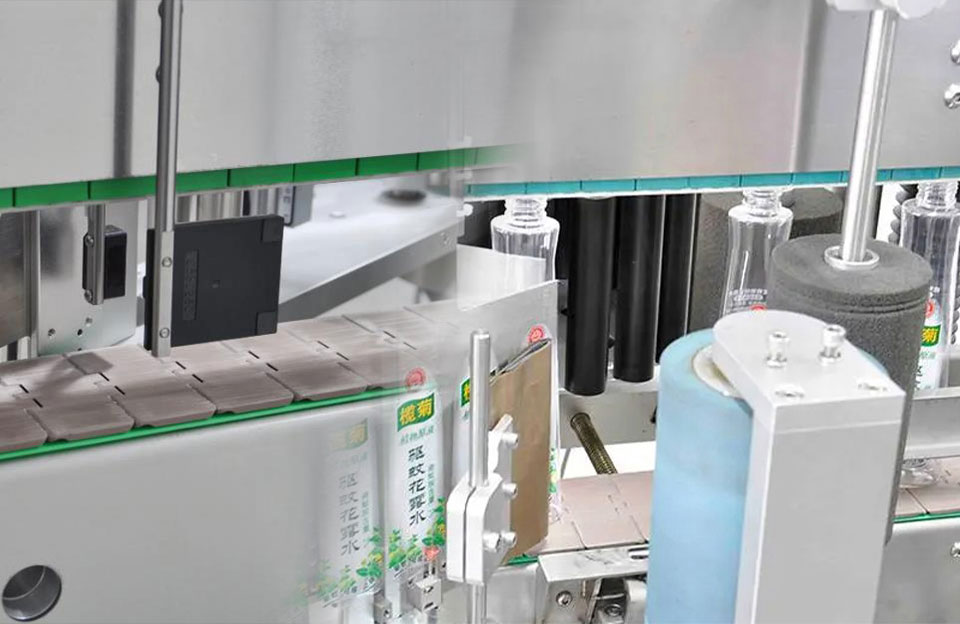Online automatic label applicators utilize sophisticated mechanisms, sensors, and automation to efficiently and accurately apply labels to sachet bags as they move along the production line while ensuring consistent labeling quality and high-speed application. Due to the convenience and accuracy of online automatic label applicators, there is an increasing demand for online sachet labeling machines.
Market Demand For Online Automatic Label Applicator
Several factors, including consumer trends, industry demands, economic conditions, and technological advancements, can influence the demand for Online Automatic label applicators.
- Convenience and Portion Control: Consumers are increasingly looking for convenient, on-the-go solutions, and sachets provide single-use serving sizes of products such as condiments, cosmetics, personal care products, and food supplements, a trend Driving the demand for pouches and labeling machines capable of applying labels efficiently.
- Cosmetics and Toiletries: The cosmetics and toiletries industry relies heavily on sachet packaging for shampoos, lotions, creams, and beauty products. Demand for pouches and labeling machines in the industry remains strong as consumers seek cost-effective ways to try new products before purchasing large quantities.
- Food and Beverage: Pouches are usually used for packaging sauces, condiments, spices, and instant drinks. The food industry’s emphasis on portion control, waste reduction, and convenient packaging has increased the demand for pouches and associated labeling machines.
- Pharmaceutical and Healthcare: The pharmaceutical and healthcare industries often require sachet packaging of single-dose medications, vitamins, supplements, and other medical products. Accurate labeling is critical to complying with regulations and ensuring patient safety.
- Emerging Markets: In developing countries, sachet packaging can provide affordable products such as hygiene products, condiments, and even basic medicines, driving the demand for sachets and labeling machines for efficient packaging and labeling of these products.
- Customization and Branding: Brands often use sachets to showcase their products in a unique and eye-catching way. This customization requires advanced labeling technology and machinery to create visually appealing packaging.
- E-commerce Growth: With the rise of e-commerce, there is an increasing demand for small, lightweight, and clearly labeled packaging solutions such as sachets. Products purchased online often require compact packaging for safe shipping and easy delivery.
- Regulatory Compliance: Many industries have stringent labeling regulations to ensure consumer safety and product information transparency, driving the need for labeling machines that can consistently apply accurate and compliant labels.
- Technological Advancement: With the advancement of labeling machine technology, manufacturers can achieve higher speed, accuracy, and versatility when labeling different pouches, encouraging enterprises to invest in newer and more efficient labeling equipment.
- Sustainability Issues: As consumers and industries become more environmentally conscious, there is a growing demand for sustainable packaging solutions, including eco-friendly bags and labels.
The Particularity of The Online Automatic Label Applicator
Sachet bag labeling applies labels to sachets, which are small flexible packaging units typically used to hold single-dose portions of products such as powders, liquids, creams, or even small solid items. Due to the uniqueness of the pouch packaging, the label of the pouch presents a certain particularity. Here are some key considerations for sachet labels:
- Small Size and Limited Space: Sachet bags limit the space available for labeling, meaning that the label’s information must be concise and well-designed to effectively convey important information.
- Legibility: Due to limited space, text and graphics on pouch labels must be legible. Font size, type, and color contrast should be chosen carefully to ensure that information is easily read.
- Regulatory Requirements: As with all packaging, sachet labels must comply with regulatory guidelines and requirements, including specific information such as product name, ingredients, directions for use, safety warnings, production and expiration dates, batch numbers, etc.
- Durability: Sachets may be exposed to various conditions during distribution and use, such as moisture, friction, and handling. Labels should be designed to withstand these elements without becoming illegible or falling off.
- Application Process: Due to the small size and flexibility of pouches, the labeling process can be more complex than larger rigid containers. Labels must be applied accurately and securely to avoid misalignment or detachment during shipping and handling.
- Material Selection: The material of the label used for the pouch needs to adhere well to the Sachet bag’s material and be compatible with the packaging process (e.g., adhesive type, label material, etc.).
- Production Efficiency: sachets are usually packaged in large batches, so the labeling process needs to be efficient to maintain production speed and minimize downtime.
- Anti-tamper Features: Depending on the type of product, Sachet bag labels may need to incorporate anti-tamper features to ensure the integrity of the product before it reaches the consumer.
Sachet bag labels must accommodate the small size of the packaging unit, regulatory requirements, durability, and efficient production. Properly executed pouch labeling is critical to product safety, consumer information, and effective branding in these single-dose packaging solutions.
How Does the Online Automatic Label Applicator Label the Sachet?
The online automatic label applicator is designed to efficiently and accurately apply labels to sachets as they move along the production line. The process involves several steps to ensure that labels are applied correctly and consistently. Here is a general overview of how the machine works:
- Sachet Feeding: Sachets are loaded onto a conveyor belt system or feeding mechanism that transports them through the labeling machine. The machine is synchronized with the speed of the conveyor belt to ensure proper alignment and timing.
- Label Dispensing: Labels are usually stored on rolls or reels. The labeling machine has a mechanism for unwinding and feeding the label material into the labeling station.
- Label Application: The labeling station consists of various components designed to precisely apply labels to pouches.
- Label Applicator: This component holds and positions labels for application to pouches.
- Applicator head: The applicator head is responsible for applying the labels to the pouches and can be combined with label dispensers, vacuum systems, etc., to achieve this.
- Applicator: The applicator ensures that labels are applied smoothly without wrinkles, air bubbles, or misalignment.
- Label Transfer: Once the pouch is properly positioned, the label is transferred from the applicator or labeling head onto the surface of the pouch, which can be done using pressure, suction, or other techniques that provide precise control.
- Label Bonding: After the label is transferred to the pouch, it must be firmly bonded. The labeling machine ensures proper adhesion by pressing rollers, smoothing brushes, or other mechanisms that press the label onto the surface of the pouch.
- Quality Control: Many labeling machines are equipped with sensors and cameras to verify label placement, alignment, and quality, helping to detect and correct any labeling errors in real time.
- Adjustment and Calibration: The labeling machine can usually be adjusted to accommodate different pouch sizes, label sizes, and positioning requirements to ensure accurate label application regardless of pouch size changes.
- Speed Control: The speed of the labeling machine can be adjusted to suit the rhythm of the production line, maintaining consistency and preventing jams or accidents.
- Waste Management: The machine usually manages any excess label material, liner, or waste from the labeling process via a winding mechanism or a waste chute.
- Integration with the Production Line: The labeling machine is integrated into the entire production line to achieve a seamless flow of sachets from packaging to labeling to further processing or packaging.
Conclusion
The demand for online automatic label applicator is influenced by changing consumer behavior, industry requirements, and the need for efficient, accurate, and visually appealing packaging solutions. Manufacturers and businesses that can effectively meet these demands will benefit in everything from food and beverages to pharmaceuticals.


